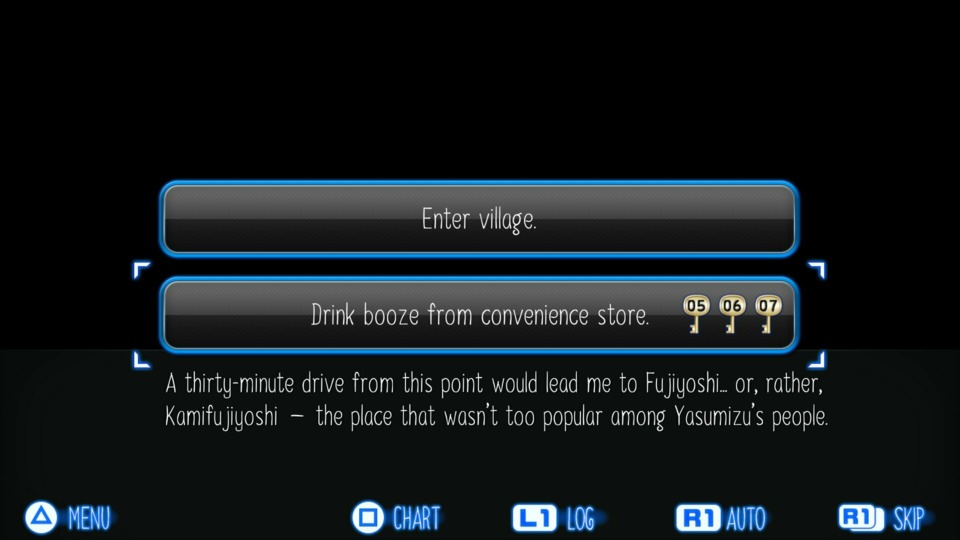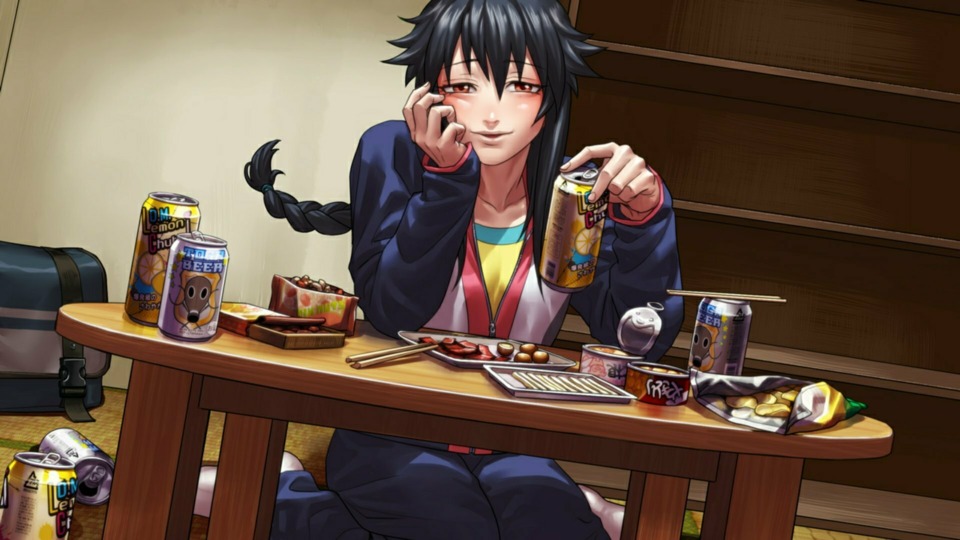VN-ese Waltz: August - Raging Loop
By Mento 3 Comments
Decided to spend the second half of 2021 checking out some renowned visual novels. Sometimes my ideas aren't any more elaborate than that. I've tried to discuss the following games in as spoiler-free a manner as possible, with a very spoilerish section at the end for my final thoughts on where the story goes.

This month's barely-interactive fiction is Raging Loop, a horror-themed survival story from Kemco. Kemco's one of those smaller game companies that figured out how to keep itself solvent over the decades: they were making console games as far back as the early NES era, but like many Japanese developers would eventually made the switch from consoles to the mobile market. Their current primary output are throwback RPGs like the Asdivine franchise. Far as I knew, they didn't have a known history with visual novels the way companies like Spike Chunsoft (the Danganronpa devs) or Idea Factory (who make a lot of otome games like Amnesia) do; two other major RPG developers who found that their storytelling experience was equally applicable to the VN genre. Kemco do have a few titles listed on the VNDB (Visual Novel Database) however, so maybe it was more that few or none of them were localized before Raging Loop. I also learned that they were the ones to port the MacVentures series to NES - Shadowgate, Déjà Vu, and Uninvited - which for many are the definitive versions, so maybe I was wrong to knock their adventure game bona fides. Like many Kemco games, Raging Loop began as a mobile exclusive game before eventually seeing ports for Steam, PS4, and Switch. Those two console ports, released close to Halloween 2019, were the first to see localizations; I've been playing the PS4 version, for the record.
Raging Loop's set-up is essentially a video game version of the social deduction card game Werewolf, with the game's tutorial-esque intro (and its title, abstractly) even saying as much: in the game's "Feast of the Yomi-Purge," there's a werewolf (or several) and their task is to kill the humans. Only one human can be killed by the wolves each night, and they are powerless to resist them. During the day, it's the humans' job to figure out which among them is a werewolf and ritually hang the chosen suspect, provided a consensus is met. Humans cannot be outside during the night; instead, they must lock themselves in individual rooms and they'll automatically fall sleep. Escaping the town is impossible due to the heavy mists. The god of the mountain who moderates the event will punish any lawbreakers, including the wolves, with the "corruption" of Yomi: sinister creatures hiding in the mists that surround the town. Those killed by the corruption have much grislier deaths, torn to unrecognizable pieces, while those killed by the werewolves - implied to be possessed by wolf spirits, indistinguishable from humans during the day - look like regular murder victims. The game also adds in some extra rules about other local animal guardian spirits that assist the humans: there's one touched by the snake, who can identify whether someone is a wolf or human once per day (the most valuable power); one touched by the crow, who can determine if a prior hanging victim of the humans was actually a wolf or human (less important early on, more so as the bodies pile up); one touched by the spider, who can protect any human besides themselves from the wolves once per night (which made it very dangerous to expose yourself as the spider); and two touched by twin monkeys, each of whom can immediately identify the other and absolve themselves of suspicion (it's explained that it'd be too risky to try to fake it - if two pairs of monkeys came forward, it's likely all four will be sentenced to death to ensure the wolves are destroyed). So far so Among Us, just with a Forbidden Siren/Fatal Frame "remote Japanese village on the edge of hell" setting.

As a novel, and a visual novel where alternative routes are present, Raging Loop has the opportunity to really dig into the game theory of this Prisoner's Dilemma variant and the many ways in which communication is an important factor. If you're into that Death Note "ah, but if he says this, I can just refute it with that" deep chessmaster strategizing shit, Raging Loop might hold some appeal. Another factor is that the protagonist, Haruaki Fusaishi, who inadvertently wanders into the village setting due to getting lost on the mountain roads, finds himself looping back to the moment he entered the region after every death with his memories intact. Other characters include: the dozen villagers, who all treat the local superstitions with a mix of reverence or distrust depending on their dispositions and ages; two journalists who are visiting the town for a feature on local food delicacies; and an amnesiac child who was found near the river. The first "loop" of the game goes badly as it leaves Haruaki, who turns out to be oddly good at these sorts of mindgames, out of the Feast owing to his status as an outsider; subsequent loops can then play out completely differently due to changed circumstances, keeping the reader guessing throughout. It also means it can regularly kill off most of its rogue's gallery a la Danganronpa, as each day usually has at least two victims (one chosen by humans, one hunted by the wolves), and then reset the loop and kill them off in a new order.
Going back to the visual novel alternative route aspect, the game pulls something I've seen a few other games of this type do - including AI: The Somnium Files - where chasing obviously bad routes is encouraged beyond getting to see some gnarly death state for your protagonist. Bad endings offer an opportunity to earn "keys"; said keys can then be used to unlock new options in earlier multiple choice prompts which lead the story in new directions. This system is elegant not only in heightening the drama of dying horribly due to your poor choices, but in giving out information that will be vital in other routes; it also means you get a faceful of nightmares on a regular basis, as you deliberately choose to wander into deathtraps and other fail states, which serve to heighten the horror theme also. It's sort of like what the movie Happy Death Day was going for: turning that Groundhog Day time-looping format into a procession of brutal demises that the protagonist can nonetheless learn from every time. The game is structured in such a way that you can always warp to any decision branch you may have left behind, and this story flowchart also helpfully highlights which keys you'll require to proceed. The game itself assures the player that's there no decision they can make that won't have an immediate and stark effect on the narrative: no making a choice and having to wait several hours to find out the repercussions, if any. It eliminates a lot of the guesswork, for good and perhaps bad - say, if you were hoping to do some sleuthing yourself, since all you really need to do to reach the true ending is to exhaust all the open branches.

It's also, like some other visual novels I've played (Steins;Gate for one), deeply referential of Japanese media and especially other video games. I guess that's knowing your audience, though it's not entirely too meta if the protagonist has played video games before and recognizes the similarities between his plight and these digital adventures. The one game it doesn't shy away from tacitly referencing is Persona 4, what with the same sinister heavy mists and Yomi (the Shinto land of the dead) playing significant roles in this small town murder intrigue. You even start the game by meeting an oddly intense conbini clerk with unusual hair. The rest are little more surface-level, like suggesting the possible presence of zombies made it like a "Japanese Resident Evil" ("Oh right, that was already Japanese," thought the protagonist to himself after a moment) and some awareness of the conventions (and possible exploitations) of time-looping, which is fair enough: it's always odd that these time-loopers have never seen Groundhog Day and can build on that movie's time-loop "lessons," though I think it did make for a gag in Palm Springs. Seeing the protagonist get smarter on every loop - inspired largely by not wanting to die again - had an appeal to it also, even if its sci-fi cleverness was sometimes tonally at odds with the chills of the serial killing mayhem. But hey, if you can't have fun with time travel, what's even the point of including it as a factor?
In the end, I enjoyed Raging Loop immensely. It was incredibly derivative - this review highlighted half a dozen other games and properties it's cribbed from - and I was dubious Kemco had it in them to make something that wasn't middling fare like the aforementioned generic mobile RPGs they're primarily known for these days, but the authors clearly understood how to weave a compelling thriller that kept flipping on you and used the game's key system to direct you in a more linear and curated fashion than it might first seem. You learn every twist and relevant tidbit of lore at the precise moment the game wants you to, even though you're bouncing around the chronological order of events like crazy, and like in Werewolf itself the most talented players of the game are the ones who elude suspicion the most and could surprise you with their cruelty and cunning. It's a fun game to play with people you only think you know for a reason after all, and why Among Us has gone on to be as successful as it has. Raging Loop - released in 2015 originally for iOS and Android - kinda presaged this model of game's sudden recent prominence in video games (Gnosia is another more recent visual novel take on the idea, not to mention Werewolf got its own movie recently), and that's an admirable quality in itself. I'm glad I took a chance on it and I continue to be impressed by the hidden mechanical depth of these outwardly simple "choose your own adventure" formats.

All right, so like last time I'm going to finish with a giant spoiler-blocked analysis of the story and how it played out:
Phew, that's probably enough. Raging Loop might not be for everyone and it has something of a cobbled-together quality to its construction, but if you're a fan of horror games and don't mind some forty hours of reading I'd recommend giving it a shot. Maybe doesn't stick in the mind quite as impactfully as The House in Fata Morgana and its more distinctive presentation, but I'm two-for-two on this VN project so far.
